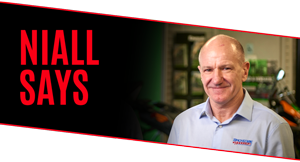
0333 0053 100

0333 0053 100


“I can’t think of any model from the Hamamatsu manufacturer that I haven’t ridden and enjoyed.
“I thought their Seventies bikes oozed personality and character and I often found myself in showrooms drooling over AP50s, three-cylinder GT 380s, 550s, and 750 Kettles, wondering if I would ever be lucky enough to ride one home.
“The flagship models moved on with the arrival of the GS range, before the iconic GSX-R rocketships hit our shores in the mid-eighties. I like the fact that every once in a while, Suzuki gets radical, with the likes of the VanVan and the long-awaited,
totally mental, B-King.
“As I said I’ve been lucky to ride most Suzukis but for some reason have only ever actually owned off-roaders. I started with 250cc and 325cc Beamish Suzuki Trials bikes before moving on to RM125, RM400, and RMX 250 Moto Crossers. My bike of choice, however, would be the latest incarnation of the GSX-R750.
"The 150bhp motor is housed in its sister’s 600cc chassis making it light and nimble but with a nice amount of extra torque and power. It’s a joy to ride on the road
but is even better on track days where it can be ridden hard with great satisfaction as it leaves more powerful sports bikes in its wake. Oh, and it has to be blue and white!”

“Suzuki is a manufacturer that I don’t have too much experience of. In the racing world, they’ve always seemed like the underdog. That said in 2005 when they brought out the GSX-R1000 K5 Superbike, they really raised
the bar and it dominated the superbike championships around the world for two or three seasons.
“Like many, I was (and still am) a massive Kevin Schwantz fan, so I always wanted Suzuki to win back in the early ’90s. Personally, I only raced one Suzuki in my career and that was in 1989, my last year of motocross. It was supplied by my good friend, the late Jim Sandiford. The truth is I didn’t get on too well with the bike as I was way too small and light for the big RM125.
"The bike used to ride me and after breaking my leg on it I called it a day on my motocross career (thankfully). The only other time I rode a Suzuki was in 2007 at a test at Cadwell Park. I’d been given the chance to test for Crescent Suzuki on their BSB bike which was a lot of fun. It certainly felt fast around Cadwell Park!”
Another of the major manufacturers in the biking world, Suzuki have a huge range of bikes available, and as such, you need to ensure you get the exact insurance you need for your Suzuki motorbike.
No matter whether you are using your bike for commuting or driving through our wonderful countryside over the weekends, you will want the best insurance you can get for your bike. With Mackenzie Hodgson you can apply for insurance over the phone on
0333 0053 100 and talk to our bike insurance experts, or just as easily online using our simple online form.
Suzuki entered the motorcycle industry in 1949 when Michio Suzuki, a 63-year-old Japanese businessman whose firm made looms for the silk industry, decided to build an engine for his bicycle. He called his 36cc, two-stroke, motor the Power Free, and
released it for sale in June 1952. It became popular, partly because it allowed the rider to give pedal assistance on hills.
The following year, Suzuki produced an improved, 60cc engine that he called the Diamond Free. Before long his factory in Hamamatsu was building and selling several thousand per month. Next he produced a complete bike, the Colleda, powered by a 90cc
four-stroke single engine. That was followed by the 125cc Colleda ST, closely based on German firm DKW’s RT125.
By this time the company was growing fast. In 1956, Michio introduced his first twin-cylinder model, a 250cc bike called the Colleda TT. In 1958 the firm began using the Suzuki name and now familiar “S” logo.
Suzuki began entering bikes in races and received a boost in the early Sixties, after East German star Ernst Degner defected, bringing the secrets of his MZ’s two-stroke technology with him. The knowledge gained led to a string of world championships
in the smaller Grand Prix classes, won on compact, high-revving two-strokes by riders including New Zealander Hugh Anderson and German ace Hans-Georg Anscheidt.
Early Suzuki production bikes had been unexciting, small-capacity commuters such as the B100P, but the firm’s image changed in 1966 with the launch of the T20 Super Six. This 247cc two-stroke parallel twin was quick, light and handled well.
Better still was the restyled, more powerful T250 Hustler that followed in 1969. A string of further twins including the T350 Rebel, GT250 and lighter, racier GT250 X7 would maintain the firm’s reputation for sporty 250cc bikes into the
late Seventies.
Larger-capacity models included the T500, an air cooled two-stroke twin that was essentially a larger version of the Super Six. It wasn’t glamorous but it was reasonably fast, reliable and inexpensive, and it stayed in production for almost
a decade. The GT380 and 550 air cooled triples added some two-stroke variety.
Suzuki’s flagship of the early Seventies was the big, bold GT750, with its bulbous shape, lurid colour schemes and liquid-cooled, two-stroke triple engine. Its output of 67bhp was unspectacular even when the original GT750J model was launched
in 1972. But the “Kettle” was a comfortable and capable tourer, and was successfully updated several times through the decade. It led to the notorious TR750 race bike derivative, nicknamed the “Flexi-Flyer” due to its speed
and evil-handling chassis.
Barry Sheene helped develop the TR750 sufficiently to win the FIM 750cc world championship in 1973, before tyre failure caused his famous high-speed crash at Daytona. The charismatic Sheene then won Suzuki’s first 500cc titles, in 1976 and ’77,
aboard the RG500 square four.
The RE-5 rotary, released in 1975, had proved a costly wrong turn but Suzuki returned to form in 1977 with the GS750, the firm’s first four-stroke superbike. The twin-cam four was closely based on Kawasaki’s Z900, albeit with smaller,
748cc, capacity. With a maximum output of 68bhp the GS was the world’s most powerful 750, and had handling to match. The GS1000 followed a year later, its outstanding chassis confirming Suzuki’s arrival as a leading superbike manufacturer.
Suzuki’s four-cylinder engine gained an important boost in 1980 with the GSX1100, whose 100bhp air cooled, DOHC powerplant contained 16 instead of eight valves. The GSX’s awkward styling didn’t match its performance but Suzuki followed
it with the stunning Katana: styled in Germany, named after a Japanese ceremonial sword, and that country’s most radical, eye-catching superbike yet. This classic Suzuki name was rebooted in 2019, with a modern day interpretation of the
iconic 1980s model.
Italian stars Marco Lucchinelli and Franco Uncini earned further headlines by winning consecutive 500cc world championships in the early eighties, on factory RG500s. Suzuki would not repeat that dominance in subsequent seasons but Kevin Schwantz and
Kenny Roberts Jr would win titles in 1993 and 2000 respectively, riding the RGV500 V4 racer.
Not everything Suzuki tried in the eighties was successful. Notable failures included the XN85, an attempt at joining the turbocharging revolution. It produced 85bhp, powerful for a 673cc four but hardly enough to justify such complexity. The neat,
quick, aluminium-framed RG250 parallel twin two-stroke of 1984 was more popular, and was followed a year later by the RG500 square four race-replica, whose aluminium frame contributed to agile handling and a total weight of just 150kg.
Suzuki’s star of 1985, and arguably of all time, was the GSX-R750. With its twin-headlamp full fairing, rev-happy four-cylinder engine and ultra-light aluminium frame, the Gixxer was a close copy of Suzuki’s works endurance racers. Its
oil-cooled, 16-valve engine produced 100bhp, and its 176kg dry weight figure was even more impressive. Its racy image and pace on road and track made it a huge hit and began a new era of race-replica sports bikes. A year later it was joined by
the GSX-R1100, which combined similar styling and layout with added midrange muscle and 125bhp top-end performance.
More success came with naked, keenly priced Bandit fours, which were popular in both 600 and 1200cc sizes. But Suzuki’s final outstanding model of the last century was another high performer. The GSX1300R Hayabusa sports tourer was created to
capture the unofficial title of world’s fastest superbike from Honda’s Super Blackbird. The Hayabusa’s ram-air boosted output of 173bhp gave a highest yet top speed of 190mph. The ’Busa handled well, and its speed and image
earned it a cult following, especially in the USA.
Suzuki struck gold again in 2001 with the GSX-R1000, which shot to the top of its class thanks to its blend of GSX-R750-based chassis and new 988cc, 161bhp powerplant. For 2005 Suzuki reinforced its dominance with the updated K5 model, featuring a
more powerful, 176bhp engine and lighter, more agile chassis. It won countless shootouts and took Troy Corser to the firm’s only world superbike title the same year.
At times Suzuki’s fortunes faded, along with the influence of the GSX-R, but the all-new 2017 model, complete with 199bhp output and MotoGP-derived variable valve timing, proved the firm is still at the forefront of producing exciting and competitive superbikes. The marque’s range still has plenty of quality and variety, with capable models including the naked GSX-S1000, versatile V-Strom, the popular, learner legal GSX-R and GSX-S125s and the popular Burgman range of maxi scooters.